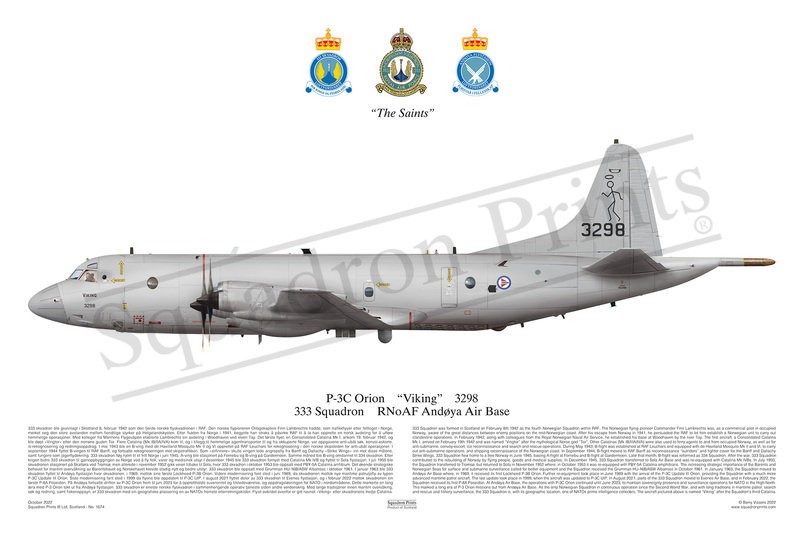#1674 333 Skv P-3C Orion print

Description
Squadron Prints Lithograph No. 1674 - 3298 (163298), P-3C Orion, "Viking", 333 Squadron, RNoAF Andoya Air Base.
333 Squadron was formed in Scotland on February 8th 1942 as the fourth Norwegian Squadron within RAF. The Norwegian flying pioneer Commander Finn Lambrechts was, as a commercial pilot in occupied Norway, aware of the great distances between enemy positions on the mid-Norwegian coast. After his escape from Norway in 1941, he persuaded the RAF to let him establish a Norwegian unit to carry out clandestine operations. In February 1942, along with colleagues from the Royal Norwegian Naval Air Service, he established his base at Woodhaven by the river Tay. The first aircraft, a Consolidated Catalina Mk I, arrived on February 19th 1942 and was named “Vingtor” after the mythological Norse god “Tor”. Other Catalinas (Mk IB/IIIA/IVA) were also used to ferry agents to and from occupied Norway, as well as for anti-submarine, convoy-escort, ice reconnaissance and search and rescue operations. During May 1943, B-flight was established at RAF Leuchars and equipped with de Havilland Mosquito Mk II and VI, to carry out anti-submarine operations, and shipping reconnaissance of the Norwegian coast. In September 1944, B-flight moved to RAF Banff as reconnaissance “outriders” and fighter cover for the Banff and Dallachy Strike Wings. 333 Squadron flew home to a free Norway in June 1945, basing A-flight at Fornebu and B-flight at Gardermoen. Later that month, B-flight was reformed as 334 Squadron. After the war, 333 Squadron contributed to the rebuilding of Norway by flying people, goods and medical supplies. In December 1945, 333 Squadron transferred to Sola Air Base and was re-equipped with Catalina Mk IVBs. In July 1950, the Squadron transferred to Tromsø, but returned to Sola in November 1952 where, in October 1953 it was re-equipped with PBY-5A Catalina amphibians. The increasing strategic importance of the Barents and Norwegian Seas for surface and submarine surveillance called for better equipment and the Squadron received the Grumman HU-16B/ASW Albatross in October 1961. In January 1963, the Squadron moved to Andøya Air Base where, in 1969, it received its first Lockheed P-3B Orion. Further re-equipment took place in June 1989 with the arrival of the P-3C Update III Orion, providing the Squadron with a much more advanced maritime patrol aircraft. The last update took place in 1999, when the aircraft was updated to P-3C UIP. In August 2021, parts of the 333 Squadron moved to Evenes Air Base, and in February 2022, the Squadron received its first P-8A Poseidon. At Andøya Air Base, the operations with P-3C Orion continued until June 2023, to maintain sovereignty presence and surveillance operations for NATO in the High North. This marked a long era of P-3 Orion missions out from Andøya Air Base. As the only Norwegian Squadron in continuous operation since the Second World War, and with long traditions in maritime patrol, search and rescue and fishery surveillance, the 333 Squadron is, with its geographic location, one of NATOs prime intelligence collectors. The aircraft pictured above is named “Viking” after the Squadron’s third Catalina.
